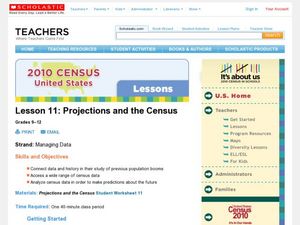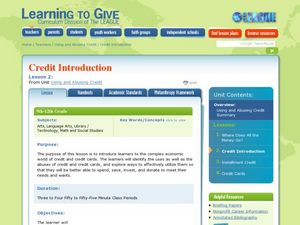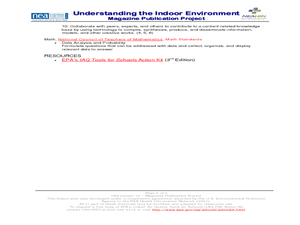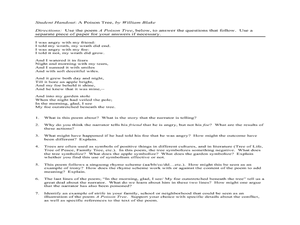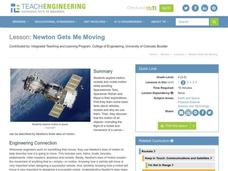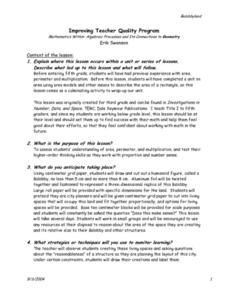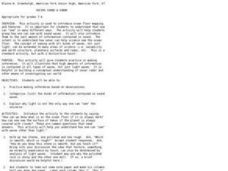Curated OER
Education, Design & Empowerment: Part One
Students consider the connection between poverty and education. In this language arts and social studies lesson plan, students research primary and secondary sources in order to explore the relationship between education and poverty.
Curated OER
Projections and the Census
Students learn why the census makes a difference. In this U.S. Census lesson plan, students connect data and history in their study of previous population booms and analyze census data in order to make predictions about the future.
Curated OER
Credit Interview
Student determine a safe debt load. In this credit interview activity, students explore the importance of budgeting, saving and investing. They examine the pros and cons of using a credit card. Students discuss how to build credit, apply...
Curated OER
Indoor Environment: A Magazine Publication Project
Students demonstrate knowledge of Indoor Air Quality by creating a class magazine. A link to order a free Action Kit from the U.S. Environmental Protection Agency is provided so teachers can build background knowledge. Performance...
Curated OER
"Tree of Peace": Critical Thinking About Revolution to Global Conflict
Tenth graders explore the importance of peace in society. In this Global History instructional activity, 10th graders create a common vocabulary for the different elements that exist in a peaceful society. Students discover...
Curated OER
Roofing and Right Triangles
Students use models and symbols to represent properties of the Pythagorean Theorem. In this right triangle lesson, students connect real jobs to properties of right triangles. They solve word problems applying the correct ratios and...
Curated OER
Knots and Braids
Learners relate mathematics to braiding and knots. In this braiding and knots activity, students calculate the components for building braids. Learners share their braids investigations.
Curated OER
What is Microbiology?
High schoolers research microbiologists. In this research lesson, students will research a microbiologist, create timeline sections, and build a timeline. High schoolers will also use a website to research a particular branch...
Curated OER
The "Art" of Baseball
Students investigate the art of baseball. In this sports lesson, students discuss their thoughts about the sport of baseball and create a baseball word list. Students use pattern blocks and drawing paper to create a...
Curated OER
Primary Lessons for Grades K-2
Students study wildlife and identify similarities and differences between their home and wild environments. In this wildlife lesson plan, students make connections between wildlife and wildlife habitats. Students then build...
Curated OER
Aqueduct Architecture: Moving Water to the Masses in Ancient Rome
Ninth graders compare ancient and modern technology in water transporting. In this lesson on the evolution of the aqueduct, 9th graders build a working aqueduct model and examine its components. They explain the importance and use of the...
Curated OER
Oasis in the Desert
Students explore the challenges of building a thriving human civilization in a desert environment. They design new technologies to assist people living in the desert.
Curated OER
Design and Construct a Road Sign Support
Students design, build, and test a model of a free-standing structure used to support overhead road signs.
Curated OER
Science: Motion Commotion
Students examine Newton's three laws of motion to discover what causes it and how it changes. They conduct motion experiments by building catapults and constructing balloon rockets. Finally, they conduct peer studies correlating...
Curated OER
Newton Gets Me Moving
Students discuss Newton's laws of motion. The conduct motion experiments by building "Newton Rocket Cars" from assorted materials. They propel the cars with rubber bands and wooden blocks and record the distance traveled on data sheets.
Curated OER
Trigometric Ratios
This lesson requires a worksheet that is not connected. It is integral to the lesson.
Curated OER
Harnessing Wind
Students explore the ways that engineers study and harness the wind. They study the different kinds of winds and how to measure wind direction. In addition, students learn how air pressure creates winds and how engineers build and test...
Curated OER
TE Activity: The Beat Goes On
Students determine what the pulse is before examining how to measure the heart rate in different situations. They build a simple device that measures the heart rate, take heart rates, and record them on a worksheet. They discuss how...
Curated OER
TE Lesson: Tsunami Attack!
Students examine how earthquakes, volcanoes, and landslides can trigger tsunami waves. They determine how engineers use sensors to detect the dangerous wave, and how they help design building that will survive the wave force and water.
Curated OER
Ecuadorian Highlands Lesson
Indigenous peoples resided in the highlands of Ecuador as far back as 5,000 B.C. To learn about the lives of these people, class pairs research the farming and the building methods, the arts and crafts, and the beliefs of the early...
Curated OER
Balobbyland City Planners
Students create a mini city using proportions that fit a model human they construct using tin foil. They plan the city including a library, sports arena, living spaces, parks and businesses. When constructing the paper buildings, they...
Curated OER
Graphics Integrates Fun
Students take digital pictures of themselves before using a stylus pen on to trace their facial features on a graphic pad. Using an Internet gallery of body drawings they complete a caricature of themselves. In two other activities, they...
Curated OER
Activity Plan 5-6: Bugs, Bugs, Bugs!
Learners become entomologists for a day. In this life science instructional activity, students go on an insect hunt and investigate insects and their homes. This leads to the creation of an insect by each student. Lesson includes a...
Curated OER
Seeing Sound & Sonar
Students make inferences based on different sounds that they hear. In this inferences lesson plan, students will hear sounds of different objects and describe the sounds based on what they hear. They will answer various questions about...



